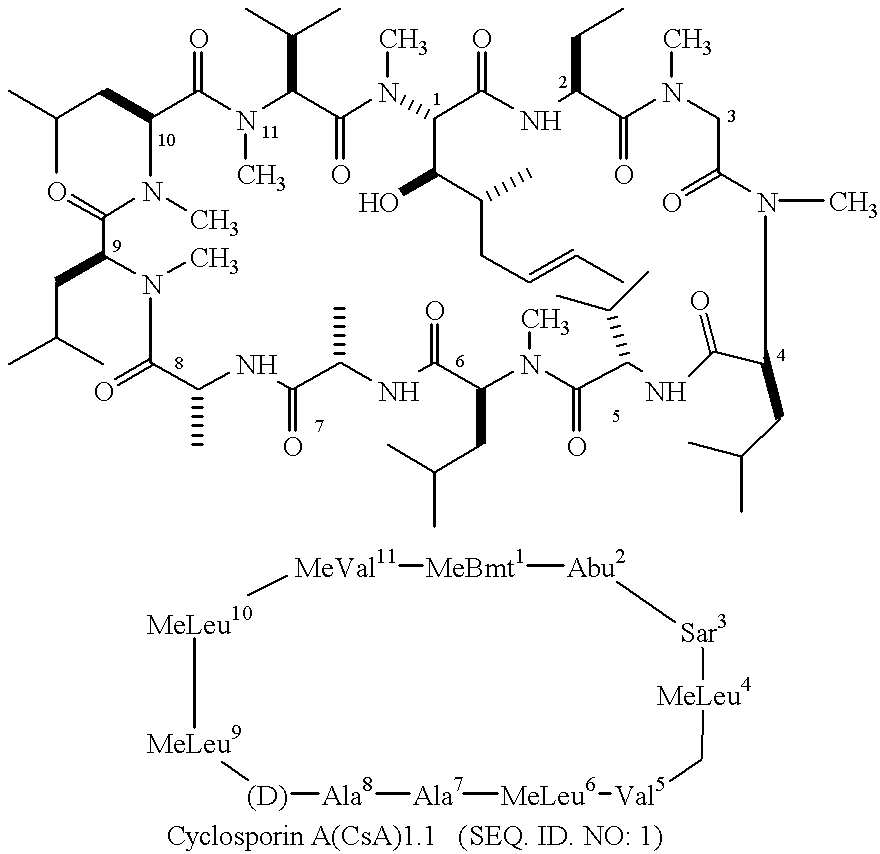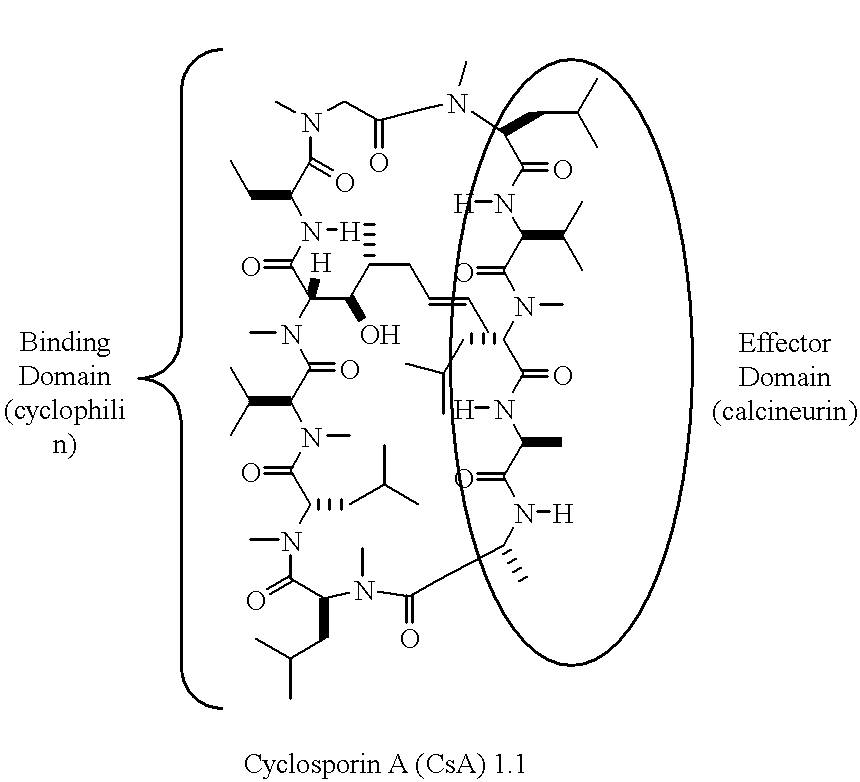Non-Imuunosuppressive cyclosporins and their use in the prevention and treatment of HIV infection
a technology of cyclosporins and cyclosporins, which is applied in the field of non-imuunosuppressive cyclosporins and their use in the prevention and treatment of hiv infection, can solve the problems of inability to inhibit, and inability to fully absorb the cytoplasm, so as to achieve the effect of increasing bioavailability and cell penetration, and reducing the risk of infection
- Summary
- Abstract
- Description
- Claims
- Application Information
AI Technical Summary
Benefits of technology
Problems solved by technology
Method used
Image
Examples
example 1
Synthesis of 2S,3R MeLeu(3-OH)
Route 1
Syn-(4S,2'S,3'R)-3-(4'-methyl-3'-hydroxy-2'-bromo-1'-pen tanoyl)4-benzyl-2-oxazolidinone 3.8
A solution of (4S)-3-bromoacetyl-4-phenyl-2-oxazolidinone 3.7 (1.7 g. 5.7 mmol) in ether (28 ml) was cooled to -78.degree. C., and treated with TEA (1.11 ml, 7.98 mmol), followed by di-n-butylboron triflate (1.73 ml, 6.04 mmol). The cooling bath was removed and the reaction was stirred at room temperature for 1.5 hours. After cooling the reaction back to -78.degree. C. with vigorous stirring, isobutyrlaldehyde (0.545 ml, 5.91 mmol) was added and the resulting reaction mixture was stirred at -78.degree. C. for 0.5 hours and at 0.degree. C. for 2 hours. The reaction was diluted with ether (50 ml), washed with KHSO.sub.4 (2X), and concentrated in vacuo. The residue was brought up in 1:1 MeOH / H.sub.2 O (20 ml), cooled to 0.degree. C., followed by addition of 30% H.sub.2 O.sub.2 (7 ml). After stirring the reaction for 1 hour at 0.degree. C., it was concentrated...
example 2
Synthesis of CsA Analogs
Boc-MeLeu-Lys(2Cl-Cbz)-OBn 4.1
Following general procedure A, the title compound was synthesized in 80% yield by coupling of the HCl salt of H-Lys(2Cl-Cbz)-OBn (8.56 g, 19.4 mmol) to Boc-MeLeu-OH (5.24 g, 21.3 mmol) in DCM (130 ml) with BOP-Cl (5.43 g, 21.3 mmol) and DIEA (10.5 ml, 60.1 mmol) to give 9.78 g of the dipeptide. R.sub.f =0.29 (30% EthOAc / hexane), [.alpha.].sub.D.sup.23 =-53.01 (c 0.415, CHCl.sub.3), FABMS (C.sub.33 H.sub.46 N.sub.3 O.sub.7 Cl) found 632.1.
Boc-Val-Melxu-Lys(2Cl-Cbz)-OBn 4.2
Following general procedure D, the Boc group in Boc-MeLeu-Lys(2Cl-Cbz)-OBn 4.1 (9.78 g, 15.5 mmol) was cleaved to form the HCl salt of MeLeu-Lys(2Cl-Cbz)-OBn, which was coupled to Boc-Val-OH (3.7 g, 17.0 mmol) in DCM (105 ml) with BOP-Cl (4.33 g, 17.0 mmol) and DIEA (8.35 ml, 48.0 mmol) via general procedure B to give 6.68 g (59% yield) of the title compound. R.sub.f =0.30 (40% EthOAc / hexane), [.alpha.].sub.D.sup.23 =-59.30 (c 0.860, CHCl.sub.3), FABMS (C.sub.38 ...
example 3
Synthesis of CS-131 Analog and CS-131 Conjugate
Boc-Ile-Phe-Oallyl
According to general procedure C, Boc-Ile-OH (3.07 g, 13.3 mmol) was coupled to the HCl salt of Phe-Oallyl (14.6 mmol) in CH.sub.2 Cl.sub.2 (60 ml) and DMF (6 ml) by using TEA (1.94 ml, 13.9 mmol), HOBt (3.047 g, 19.9 mmol), and EDCI (2.79 g. 14.6 mmol). The product was purified by flash chromatography using 30% EthOAc / Hexane as the eluant to give 78% yield the title compounds an oil. R.sub.f =0.38 (40% EthOAc / hexane). [.alpha.].sub.D.sup.23 =+15.6 (c 0.455, CHCl). FABMS (C.sub.23 H.sub.34 N.sub.2 O.sub.5) found 419.2 (M+H.sup.+).
Boc-Pro-Ile-Phe-Oallyl 5.6
After cleavage of the Boc group from Boc-Ile-Phe-Oallyl according to general procedure D, the HCl salt of Ile-Phe-Oallyl was coupled to Boc-Pro in DMF (60 ml) via general procedure C, by using TEA (1.94 ml, 13.9 mmol), HOBt (3.047 g, 19.9 mmol), and EDCl (2.79 g. 14.6 mmol). After workup, the product was crystallized from cold EthOAc to give the title compound in 73% ...
PUM
| Property | Measurement | Unit |
|---|---|---|
| dissociation constant | aaaaa | aaaaa |
| molecular weight | aaaaa | aaaaa |
| molecular weight | aaaaa | aaaaa |
Abstract
Description
Claims
Application Information
 Login to View More
Login to View More - R&D
- Intellectual Property
- Life Sciences
- Materials
- Tech Scout
- Unparalleled Data Quality
- Higher Quality Content
- 60% Fewer Hallucinations
Browse by: Latest US Patents, China's latest patents, Technical Efficacy Thesaurus, Application Domain, Technology Topic, Popular Technical Reports.
© 2025 PatSnap. All rights reserved.Legal|Privacy policy|Modern Slavery Act Transparency Statement|Sitemap|About US| Contact US: help@patsnap.com



